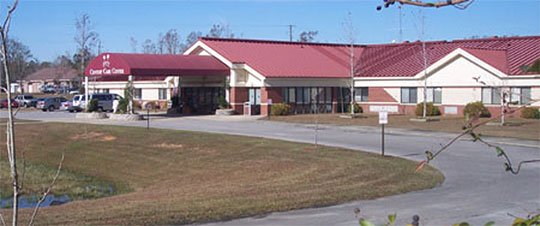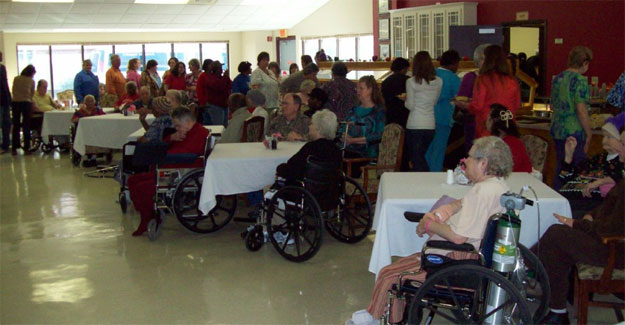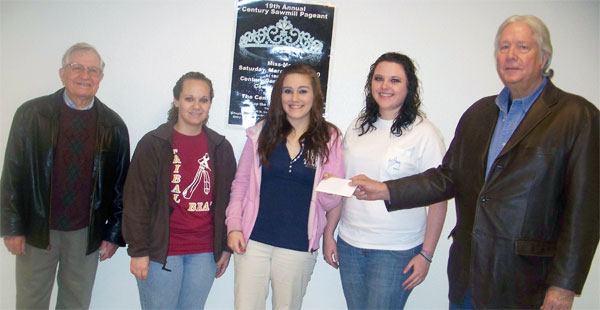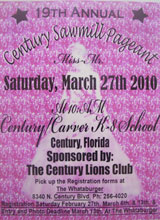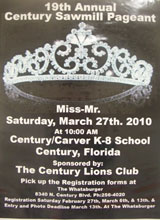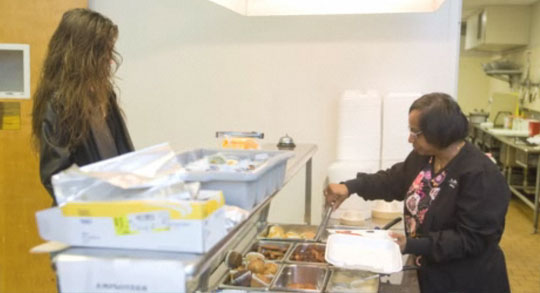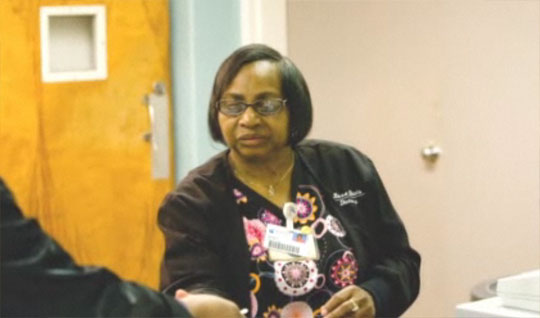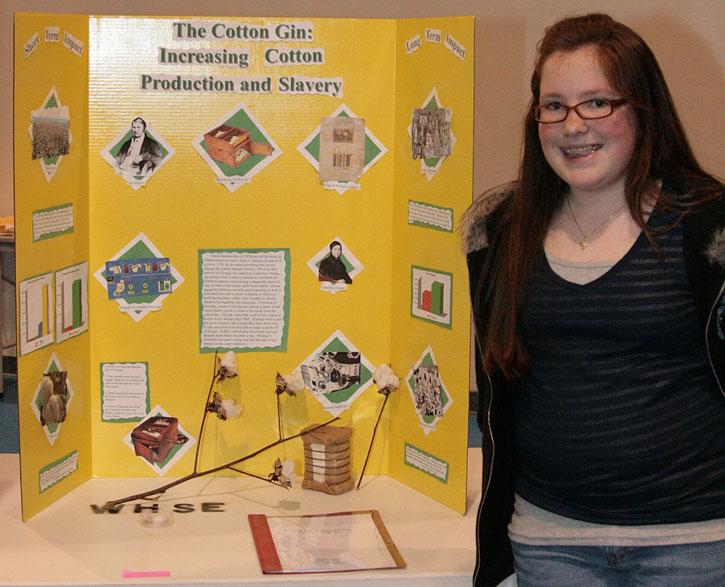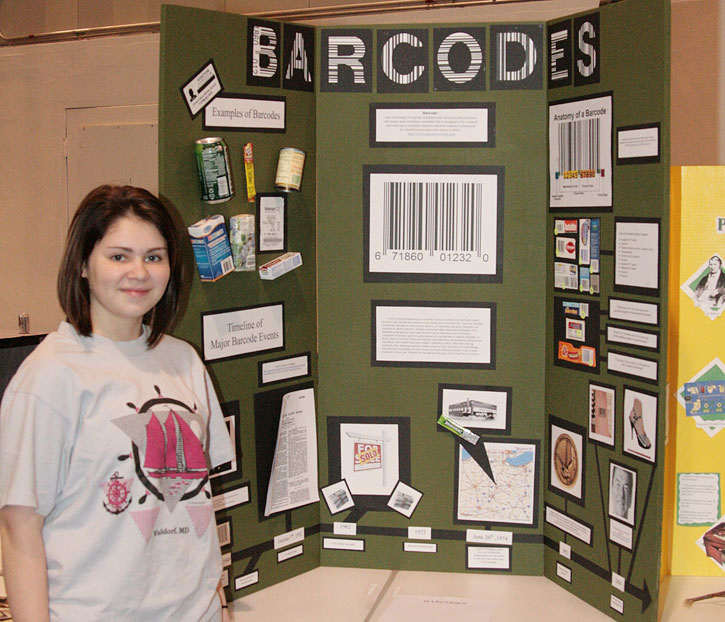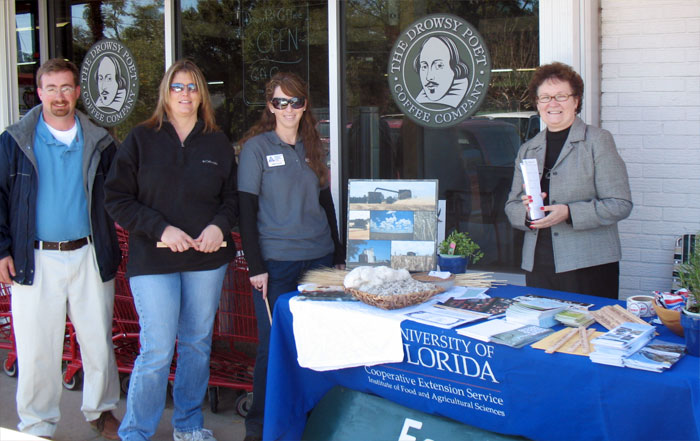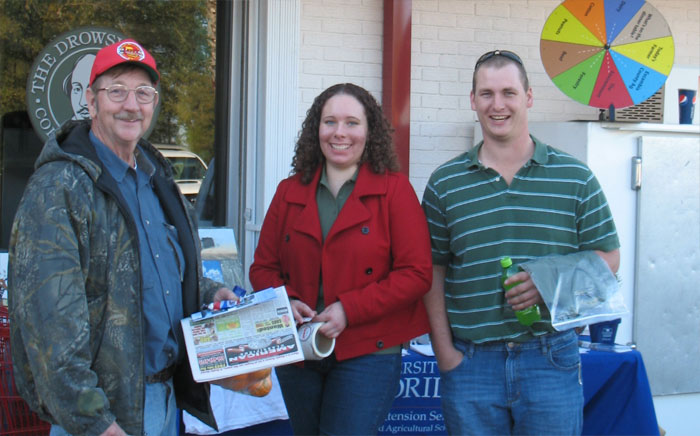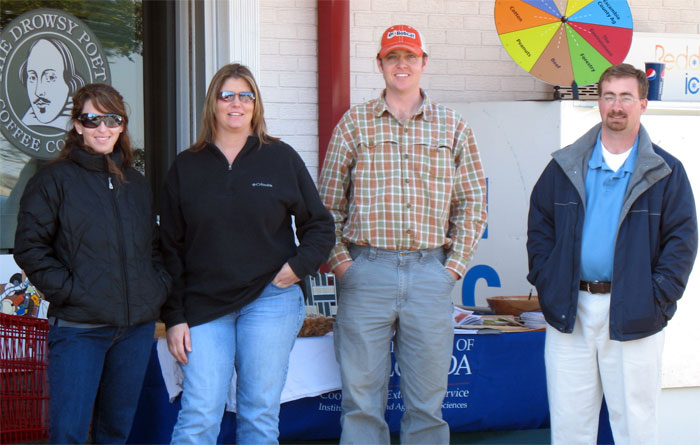Don’t Be In A Hurry To Fertilize Your Lawn
March 6, 2010
Warmer weather is arriving, but don’t be in a hurry to fertilize your lawn — that’s the word from the University of Florida IFAS Extension office.
Even though it is still winter, now is the time of year that local garden centers begin major advertising campaigns to sell lawn fertilizers. It is too early to fertilize your lawn.
Fertilize when the lawn is actively growing
 Warm-season lawns, including St. Augustinegrass, zoysiagrass, and centipedegrass go dormant in winter in Northwest Florida. Fertilizing now would be a waste of time and money. Why shouldn’t you fertilize warm-season grasses when they are dormant? First, when grasses are dormant, their roots are not able to absorb or use the nutrients from fertilizers. By the time the grass does begin actively growing, most of the nitrogen you applied will have been lost from the soil. A safe time to apply your first lawn fertilizer is around April 15th.
Warm-season lawns, including St. Augustinegrass, zoysiagrass, and centipedegrass go dormant in winter in Northwest Florida. Fertilizing now would be a waste of time and money. Why shouldn’t you fertilize warm-season grasses when they are dormant? First, when grasses are dormant, their roots are not able to absorb or use the nutrients from fertilizers. By the time the grass does begin actively growing, most of the nitrogen you applied will have been lost from the soil. A safe time to apply your first lawn fertilizer is around April 15th.
Don’t feed the weeds
Fertilizing while the grass is dormant actually encourages more winter weeds, because you are fertilizing the weeds instead of the lawn. Without competition from the lawn, these weeds will grow faster and become more prolific as a result of dormant fertilizer applications.
Lastly, fertilizing lawns during their transition into dormancy in the fall or out of dormancy in the spring may encourage lawn growth that is more likely to be injured from winter kill. Bare spots and thinning of the lawn as well as delay in spring green-up may occur when lawns are forced to grow when they should be dormant.
Combo products not the answer
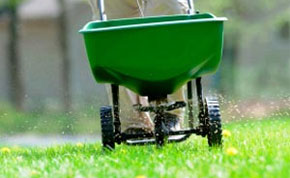 Many of the products available are convenient “weed and feed” products that combine a pre-emergent herbicide and fertilizer in one application. Unfortunately, the ideal time to apply a pre-emergent herbicide is very different than the ideal time to apply fertilizer for warm-season lawns.
Many of the products available are convenient “weed and feed” products that combine a pre-emergent herbicide and fertilizer in one application. Unfortunately, the ideal time to apply a pre-emergent herbicide is very different than the ideal time to apply fertilizer for warm-season lawns.
In northwest Florida, the recommended application window to maximize the effectiveness of preemergent herbicides is typically between February 15 and March 5.
The application timing for these products is critical since they must be applied before summer annual weeds germinate in spring. It’s always better to apply preemergent herbicides a little earlier rather than too late. And don’t forget to activate them by watering them into the lawn.
For St. Augustine grass, centipede grass, and other warm-season grasses, buy fertilizer that is separate from the pre-emergent herbicide. Apply each at their recommended times.
Finding a separate pre-emergent herbicide, not in weed-n-feed form, may be difficult. Some ones to look for include: benefin (Sta-green Crabgrass Preventer, Hi-Yield Crabgrass Preventer), pendimethalin (Pre-M, Pendulum, Turf Weedgrass Control, Halts Crabgrass Preventer), and bensulide (Green Light Betasan Crabgrass Preventer).
Start with a soil test
A soil test is always a good starting point before investing in fertilizer or lime. Your local University of Florida County Extension office can help you get started.
Theresa Friday is the Residential Horticulture Extension Agent for Santa Rosa County.
Century Care Center Unveils New ‘Person Centered’ Care Model
March 4, 2010
Whether it be at the Teaspoon Cafe or down on Dogwood Lane, there’s a new way of taking care of residents at Century Care Center called the “Person Centered Care Model”.
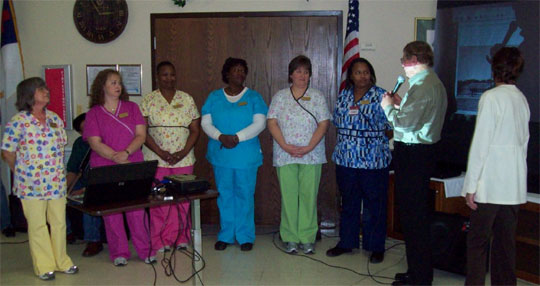 “Our goal is to keep our residents safe, happy, healthy and as active as possible. The Person Centered Care Model gives them more choices, self-respect, independence and keeps them physically and mentally active as possible,” said Don Ripley, Century Care Center administrator.
“Our goal is to keep our residents safe, happy, healthy and as active as possible. The Person Centered Care Model gives them more choices, self-respect, independence and keeps them physically and mentally active as possible,” said Don Ripley, Century Care Center administrator.
Under the Person Centered Care Model, residents are allowed to reasonably keep their lifelong daily rituals. Now, residents get choices like their waking or bedtime, what time they want to eat and their dining preferences.
“They will be asked when they want to take a bath or shower, when they want to get their room cleaned and how they want to decorate their room. People are asked what they want to do each day, activities of their choice that are of interest to them, like going shopping, going for a ride through their old neighborhoods, going to the church of their choice, picnic in the courtyard or by the Ole Mill Pond, doing a little fishing in their own stocked fish pond, card games, painting, music…or any other thing that would help pass the time away.”
 New “communities” and “neighborhoods” have been established within the facility. Hallways and rooms like therapy, dining and showers have been given familiar names from the Century area. Jerry Fischer and Don Sales of the Alger-Sullivan Historic Society assisted Century Care Center in selecting some historic names, such as Spanish Moss Road, Mystic Springs; Dogwood Lane, Country Lane, Teaspoon Cafe, The Spot and Paradise Place.
New “communities” and “neighborhoods” have been established within the facility. Hallways and rooms like therapy, dining and showers have been given familiar names from the Century area. Jerry Fischer and Don Sales of the Alger-Sullivan Historic Society assisted Century Care Center in selecting some historic names, such as Spanish Moss Road, Mystic Springs; Dogwood Lane, Country Lane, Teaspoon Cafe, The Spot and Paradise Place.
The Century Care Center staff has been trained by Eric Haider, CEO and president on Person Centered Care, Inc. and founder of the Person Centered Care Model.
“People who live in long term care communities are not second class citizens. They have worked hard for us. They have fought in the wars and risked their lives to protect our freedoms … let’s not take their freedoms away,” Haider said. “Person Centered Care gives personal attention to the people who live in long term care and empowers staff to be a resident advocate.”
Ripley said the changes “should make Century Care Center the best place to work and will, especially provide our treasured Residents with the happiest and best care, both physically and emotionally, for the rest of their lives”.
Century Care Center was recently named as the Business of the Year by the Century Area Chamber of Commerce The 88-bed facility is ranked by the U.S. Department of Health and Human Services as the number one of 69 nursing homes within 100 miles of Century
Pictured top: Century Care Center. Pictured top inset: The Person Center Care Model is introduced. Pictured bottom inset: A Century Care Center resident enjoying time by the Old Mill Pond. Pictured below: Residents in the “Teaspoon Cafe” at Century Care Center. Submitted and NorthEscambia.com photo, click to enlarge.
NHS Digital Design Students Win Pageant Poster Contest
March 4, 2010
Northview High School’s Digital Design classes participated in a 19th Annual Century Sawmill Pageant poster contest sponsored by the Century Lions Club.
Alissa Fiellin placed first in the contest to create the best poster to promote the pageant. Alex McDonald placed second in the poster contest, and Erin Fremin placed third. Fiellin received a $25 prize for her efforts.
The posters will be used to promote the annual Century Sawmill Beauty Pageant on Saturday, March 27 at 10 a.m. at Carver/Century K-8 School. Registration forms are available at Whataburger in Century.
Pictured: (L-R) Century Lions Club member Edsol Smith, Century Sawmill Pageant Poster Contest winners Erin Fremin, third place; Alissa Fiellin, first place; and Alex McDonald, second place; and Lions member Don Sales. Pictured below: Posters by (L-R) Alex McDonald, Alissa Fiellin and Erin Fremin. Submitted photos for NorthEscambia.com, click to enlarge.
Hospital Employee Named A ‘Legend’ For Helping Others
March 3, 2010
Baptist Health Care has recognized employees who go above and beyond to improve the quality of life for people in the communities served by the organization, including an employee at Atmore Community Hospital.
The health care company recently honored the employees as part of the their “Legends” program.
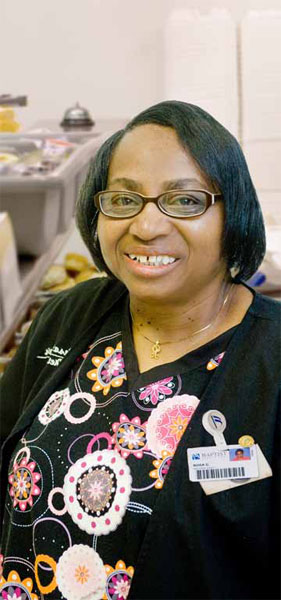 Rosa Davis is a dietary aid and cook in the food services department at Atmore Community Hospital.
Rosa Davis is a dietary aid and cook in the food services department at Atmore Community Hospital.
Davis is a woman of small stature, but has a big heart and strong commitment to helping many people in her community through some challenging situations.
When one neighbor’s home was destroyed by fire, Davis immediately offered her home as a source of shelter. She gathered clothes, food and necessary household items to help comfort and support the family. A few weeks later, one of the family members suddenly became ill. The family did not have the resources to get a much-needed prescription filled, so Davis went to the drug store, purchased the medication and delivered it to the family.
When Davis got news that another neighbor was unable to pay her electric bill, Rosa paid the bill and the power was returned to her neighbor’s home.
Lastly, Davis’ brother had to leave his home when it became flooded with more than a foot of water. Again, Davis was on the scene with food for the family. She arrived with cleaning supplies, too, and went to work putting the house back to order. Davis also serves the community-at-large through local churches.
“Rosa Davis has helped many people in her community through some challenging situations,” said Donna Rogers, director of food services. “Rosa…stands out as a Legend to all of the staff at Atmore Community Hospital.”
Other area Baptist employees nominated for “Legends” status included Stephanie Bain, a nurse manager in the operating room at Jay Hospital and Darren Flott, director of cardiopulmonary services at Atmore Community Hospital.
Pictured: Rosa Davis of Atmore Community Hospital, a Baptist Health Care “Legend”. Courtesy photos for NorthEscambia.com, click to enlarge.
Making History: Molino Park Students Recognized At County History Fair
March 3, 2010
Several Molino Park Elementary School students were recognized during the recent Escambia County History Fair.
“We were so proud of our students,” said Ester Robinson, fourth grade teacher. “All of our 4th grade students participating in the History Fair worked hard on their projects.”
The following Molino Park Elementary School students were recognized:
Elementary Individual Exhibits
- 2nd Place Kyle Lovell (Garrett Morgan Project)
- Honorable Mention: Hunter Rogers (Jackie Robinson Project)
African American Heritage Awards, Individual Elementary
- 1st Place: Kyle Lovell
- 2nd Place: Carson Lowery
- 3rd Place: Hunter Rogers
African American Heritage Awards, Group Elementary
- Sabra Stewart & Devin Abrams (African American Women: Seeds of Greatness Project)
The Holly Benson Women’s History Award
- Elementary: Carson Lowery (Harriet Tubman Project)
Historical Exhibit Awards: Elementary
- 2nd Place: Kyle Lovell
Escambia County Council of PTA/PTSA Awards
- Sabra Stewart
- Devin Abrams
T. T. Wentworth Museum Best in Show Awards
- Kyle Lovell
- Hunter Rogers
Pictured: Molino Park Students participating in the recent Escambia County History Fair were: (front L-R) Devin Abrams and Sabra Stewart; (back L-R) Kyle Lovell, Carson Lowery, Hunter Rogers, and Ali Carter. Submitted photo for NorthEscambia.com, click to enlarge.
Students Of The Month Named
March 2, 2010
Escambia County Students of the Month for February have been named by the Escambia Association for Administrators in Education. The awards are presented monthly to two students from participating schools.
The following students were named from North Escambia area schools:
- Bratt: Kendrell B. Lowery, third grade; Jaylee S. Redmond, kindergarten.
- Jim Allen: Hunter L. Myrick, kindergarten; Kendall E. Newton, kindergarten.
- Molino Park: Reagan G. Daniels, kindergarten; Jaden I. Lewis, kindergarten.
- Ernest Ward: Kelton J. Wooten, seventh grade; Kyle A. Wood, eighth grade.
- Ransom: Britton S. Dunn, eighth grade; Anna M. Del Gallo, eighth grade.
- Northview: Jessica N. Bloodsworth, senior; Seth M. Leonard, senior.
- Tate: Amy E. Sapp, freshman; Tyler D. Emmons, senior.
Pictured top: Seth Leonard and Jessica Bloodsworth, Northview High School’s Students of the Month for February. Submitted photo for NorthEscambia.com, click to enlarge.
Ernest Ward Students Awarded At History Fair
March 1, 2010
Several Ernest Ward Middle School students received awards Saturday for their National History Day projects in a district competition in Pensacola. Victoria Wright’s “Barcode” project won a NSDAR Excellence in History Award, and she received Honorable Mention in the county competition. She also received a T.T. Wentworth Museum Best in Show Award given by West Florida Historic Preservation, Inc.
Courtney Solari’s “Cotton Gin” project won third place in the African American Heritage Awards given by the Omega Psi Phi Fraternity.
Samantha Barrow and Tamara Green’s “Women’s Suffrage” project won a Holly Benson Women’s History Award and they also received $50 each for their win.
“I was very proud of all of our students,” said Ernest Ward geography teacher Laura Chavers.
The top seven projects from a Ernest Ward History Fair headed to the district competition. EWMS students were required to do research into a topic on the theme Innovation in History: Impact and Change. The research was presented in exhibit form, much like the typical science fair. Students complete projects either individually or in teams of two.
Pictured top: Tamara Green (left) and Samantha Barrow – Womens Suffrage. Pictured below: Courtney Solari – The Cotton Gin: Increasing Cotton Production and Slavery. Pictured bottom: Victoria Wright — Barcodes. NorthEscambia.com photos, click to enlarge.
EscaRosa Young Farmers and Ranchers Reach Out To Grocery Shoppers
March 1, 2010
The EscaRosa Young Farmers and Ranchers recently worked over the weekend to educate Pensacola residents about the economic value, diversity, and importance of agriculture in Escambia and Santa Rosa counties.
The group set up an informational display outside of Apple Market Grocery on Scenic Highway in Pensacola. Store owner David Apple, known for his support of local products, generously allowed the group to continue to spread the message about agriculture.
Over a six hour period, the EscaRosa Young Farmers and Ranchers introduced more than 100 people to our counties’ rich agricultural heritage and focusing on the positives of agriculture. Dorothy Lee, Escambia County Family and Consumer Science agent, developed a “Grocery Shopping List and Tips” to help people stretch their food dollar, while other members of the group tempted passersby with peanuts, “Test your Ag Knowledge game”, “I met a Farmer” stickers, and hosts of other goodies.
EscaRosa Young Farmers and Ranchers display was in partnership with UF IFAS Escambia County Extension and Escambia County Natural Resource Conservation Division, and it was made possible by the generous donations of the Escambia County Farm Bureau and Farm Credit of Northwest Florida.
Pictured top: (L-R) Jacob Gilmore, Young Farmers and Ranchers member from Gizmo Angus Farm; Debbie Williams, Escambia County Natural Resource and Conservation Division; Abbie Rolph Young Farmers and Ranchers chairwoman; and Dorothy Lee, UF IFAS Escambia County Family and Consumer Science agent. Pictured below: Tab Jernigan, Andrea Byars, and an agricultural enthusiast pose for the camera. Pictured bottom: Abbie Rolph, Debbie Williams, Cheyenne Gibbs, and Jacob Gilmore smile for the camera during a brief lull from visitors. Submitted photos for NorthEscambia.com, click to enlarge.
Turning Brown: How To Help Your Palm Recover From The Cold
February 28, 2010
Many varieties of palms across the North Escambia area are brown and sometimes even dead in appearance following our extremely cold weather. Drs. Monica Elliott and Tim Broschat from the University of Florida provide the following tips on how to cope with damaged palms.
Patience is essential with cold-damaged palms! If the palm leaf has any green tissue remaining, the leaf should not be removed until later in the year. Leaving damaged leaves on the palm during the remainder of the winter may actually help the palm survive future cold events. Once the palm has produced substantial new growth (2 to 3 new leaves), damaged leaf tissue can then be removed.
All new leaves of a palm develop from the apical meristem or bud located in the crown of the plant. It is the bud that really needs to be protected. Leaf bases naturally provide insulating protection to the bud. This natural protection is one reason not to over trim palms at any time of the year.
As warmer weather returns, primary or secondary plant pathogens often attack stressed plants through the cold damaged tissue. Copper fungicides are recommended as an attempt (not a guarantee) to protect the bud and developing leaves from diseases that may attack damaged leaf tissue. There is no research to confirm if this is effective or not. The recommendation is based on what has been observed regarding cold damage to palms and knowledge of fungicides. In most situations, it is the base of the spear leaf not yet emerged from the whorl of leaf bases that is damaged first, leading to a spear rot, which may then lead to a bud rot. Thus, the goal of a copper fungicide is to prevent this spear rot from developing into a bud rot that kills the bud, and thus the palm.
Copper fungicides are recommended over all other group of fungicides because they have broad activity against both bacteria and fungi. No other fungicides have this broad spectrum of activity. You must have complete coverage of the target tissue to be effective – in this case, the base of the spear leaf and the bud. This is more difficult to accomplish in some palm species than others, particularly those with crown shafts, because the leaf bases tightly surround the emerging spear leaf, preventing movement of a fungicide into the bud region.
If the spear leaf does rot and can be easily pulled from the bud, it should be removed immediately, followed by a copper fungicide spray or drench of the bud region, which is now exposed.
The normal recommendation is to apply the copper fungicides no more than twice because of the possibility of copper phytotoxicity. If it is believed that more chemical protection of the bud is needed after the copper fungicides have been applied, a broad-spectrum contact fungicide may be beneficial.
You will not know if the palm has survived the cold until new growth emerges, which may be 4 to 7 months later. Hence, the need for patience! The new growth may be severely malformed or damaged, but the emergence of any living leaf tissue is a sign the palm is alive. Subsequence leaves will gradually improve in quality, but it may take as long as a year before normal leaves emerge.
Escambia Farm Bureau Marks Annual Food Check-Out Week
February 27, 2010

The Escambia County Farm Bureau recently celebrated Food Check-Out Week, the week into the new year where the average household will have earned enough to pay for its food for a year.
The average cost of food in America remains affordable overall. According to the most recent information from the Agriculture Department’s (USDA’s) Economic Research Service, American families and individuals spend, on average, less than 10 percent of their disposable personal income for food.
With the continuing economic squeeze, many Americans are concerned that the cost of a healthy diet is out of reach. However, according to an Agriculture Department study, the cost of eating healthy has not changed as much as less-healthy alternatives. But eating healthy food within a budget does require smart shopping.
Farm Bureau’s Food Check-Out Week is devoted to helping teach Americans how to stretch their grocery dollars with healthy, nutritious food. America’s farmers and ranchers are committed to producing safe, healthy and abundant food. And they share a common concern with consumers when it comes to putting nutritious meals on a table while sticking to a tight budget. U.S. consumers still spent under 10 per cent of their disposable income on food according to the latest USDA data. Consumers in other countries spend much more: France- 14 percent; Japan-15 percent; China-35 percent; Philippines-37 percent and Indonesia- 46 percent.
A recent USDA report favorably supports the economics of healthier eating. Recent food price data show that prices for unprepared, readily available fresh fruit and vegetables have remained stable relative to dessert and snack foods, such as chips, ice cream and cola. Therefore, as defined by foods in the study, the price of a “healthier” diet has not changed compared to an “unhealthy” diet.
Farm Bureau’s Food Check-Out Week is aimed at helping American consumers learn how to shop effectively to put nutritious meals on the table with fewer dollars.
“Learning to use your grocery dollars wisely ensures that nutrition isn’t neglected,” according Dorothy Cunningham of Escambia Farm Bureau Women’s Committee. “Fruits and vegetables – along with whole grains, low-fat dairy products, lean meats, fish, beans, eggs and nuts – are an important part of a healthy diet. Buying fresh produce when it is in season and costs less, while buying frozen fruits and vegetables when they are not in season, is a smart way to stretch that dollar.”
Here are some tips that consumers can follow to help stretch their food dollars :
Plan ahead before going to the grocery store. Make a list of the foods you want to serve during the next week. Check your newspaper for grocery store ads and coupons. Stick to your list. Do not go to the cookie or snack aisle if you don’t “ need” to. Shop the perimeter of the store. Produce, dairy products and meat are generally found on those outside walls. A tip for keeping produce fresh longer is to store it in a perforated plastic bag. This stops condensation and shriveling. Make holes in a plastic bag with a paper punch, knife or another sharp object about six inches apart all over the bag. When you get home, immediately store any fresh or frozen products especially meat.
For more specific information on nutrition , meal planning and food preparation, contact a registered dietitian.


